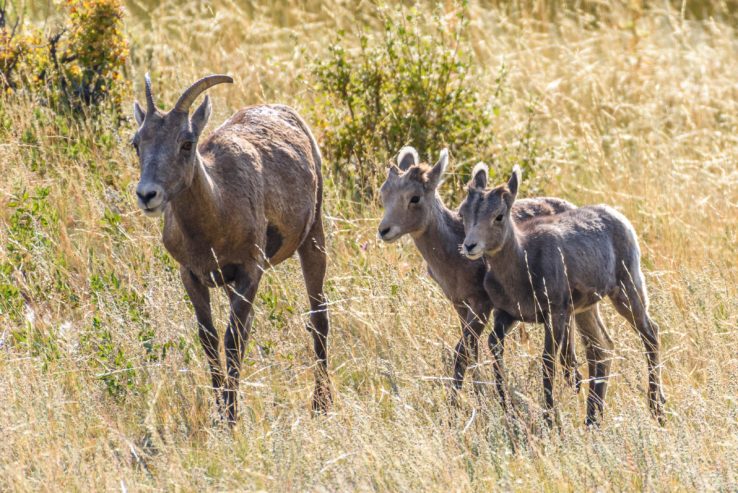Colorado is as known for its wildlife as its craft beer and altitude; and while there may be no lions or tigers, there are plenty of bears and other majestic creatures roaming the plains and mountain sides.
If you’re a newcomer to the Centennial State, experiencing the Rocky Mountains starts with understanding the local animals and coexisting with a variety of creatures. Learning about them all certainly takes some time (Colorado is home to nearly 1,000 species), so let’s start with five of the most renowned:
The American Bison
Thanks to conservation efforts, the American bison is easily spotted in Colorado if you know the hoofed hotspots (such as Genesee Park, where you can often see them while driving on I-70). These animals can weigh more than 2,500 pounds and reach heights of 6.5 feet, making them the largest land animal native to North America.
Bison are inquisitive and may approach people because of curiosity, but don’t mistake this for friendliness! These beasts are wild, unpredictable, and extremely fast when scared or angry; they can run up to 40 miles an hour. In other words, much faster than you!
Rocky Mountain Bighorn Sheep
No Colorado wildlife list is complete without mention of bighorn sheep, a species designated as the state animal in 1961. Known for their agility and grace, these animals are usually only found in rocky areas of the mountains; and are often seen climbing boulders and (seemingly) defying gravity.
The signature feature of bighorn sheep is, unsurprisingly, their big horns. Unlike antlered animals, these sheep do not shed their horns annually and they continue to grow. In fact, they can get so large that a pair of horns on a ram can weigh 30 pounds!
Black Bears
While it’s not impossible for a grizzly or brown bear to find its way into Colorado, most experts agree that black bears are likely the only bears in the region (although they can come in various shades of color). If you’re an avid hiker, mountain biker, or camper, there’s a good chance you’ll see one eventually. To be proactive, hike in groups, wear bells to warn bears that you’re approaching, and carry bear spray just in case.
In general, black bears aren’t interested in bothering people, although food makes them much more motivated and audacious. On the off chance one confronts you, talk in a normal voice, give the bear plenty of space and an escape route, wave your hands above your head, and back away while maintaining eye contact. Never run away or climb a tree; bears are far superior in these areas.
It’s often recommended to play dead if you’re attacked by a brown bear or a grizzly, yet black bears are different; if one charges you, fight back! Use rocks, sticks, water bottles, keys, or anything else as a weapon.
Mountain Lions
You can live for 100 years in Colorado and never see a mountain lion, but — chances are — several of them will see you! It’s not unheard of for one of these big cats to wander into the suburbs, even though you’re far more likely to see one if you’re in the foothills, woods, or mountains.
Mountain lion attacks are rare; they’re most likely to attack when they’re rabid, starving, or cornered. However, some mountain lions will go after cats or dogs, which means you should never take your pets (or small children) into areas with high cougar activity. Mountain lions may also attack if they are with their kittens; never approach a cub, no matter how cute they are.
If you’re ever approached by a mountain lion, use your coat or backpack to make yourself seem larger, yell, wave your arms, and throw whatever you can. If you have small kids or pets, pick them up and then return to a standing position. Back away slowly and give the cat space to leave. Do not run or turn away. Just as with a black bear, if a mountain lion attacks, fight back any way you can.
Coyotes
Coyotes are everywhere. They most often live on prairies, in forests, and in the mountains and foothills, but it’s common to see one running alongside a busy road or roaming the walking trails near residential neighborhoods.
It’s extremely rare for a coyote to pose a threat to people (and their small size makes it unlikely for them to do any serious harm even when they are aggressive). They may, however, pose a threat to pets. If you live near open space, never let your chihuahua or cat outside alone, especially at night. Coyotes are good jumpers and climbers, so fences don’t always deter them.
Even so, pets are not a main food group for coyotes. They are opportunistic hunters and far more likely to go after rabbits, birds, squirrels, mice, and easier-to-catch prey.
Living in Colorado means co-existing with wildlife. To do this seamlessly, keep these tips in mind and keep a camera in your car; you never know what you might see.
Independence in Elizabeth, Colorado, offers beautiful new homes with views for miles. Contact us to learn more about what we have to offer.

